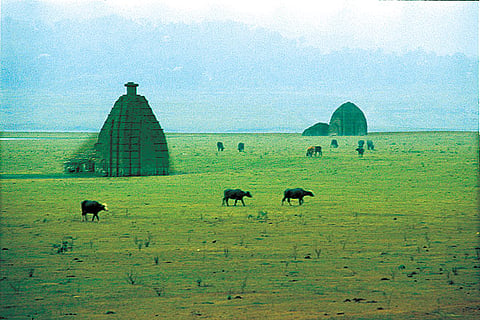
- Destinations
- Experiences
- Stay
- What's new
- Editor’s Picks
- Responsible Tourism
- CampaignsCampaigns
- Subscribe

A vast, lifeless expanse torn in two by the swift flowing Satluj. It reminds me of the greedy man in Tolstoy&rsquos story who runs from dawn till dusk to claim as much of the Steppe as he can and finally dies of exhaustion. I don&rsquot plan to run so far but run I must if I have to see the remains of all of old Bilaspur&rsquos temples.
The visit is well timed. Early winter and a bad monsoon have left water in Gobind Sagar, Bhakra Dam&rsquos reservoir, at its lowest in years. Old Bilaspur, which was submerged during the late 1950s, has risen for yet another winter, albeit with an extra blanket of silt.
The town is gone&mdashshattered by the swelling waters, buried under the silt of decades&mdashbut its beautiful temples have managed to hold out thanks to their stone construction. As I near the first group of four temples built in the shikhara style, it becomes clear that water has not entirely spared them.
Only the base of the fourth temple remains, the superstructure having collapsed around it. This, though the four stand at a relative height and are the first to emerge when the water level declines. The other three temples are in good shape although the stone cladding their walls has come loose in places. The temple in the middle is larger than the other two and has human, geometrical and floral figures carved on its walls. It was apparently dedicated to a principal deity like Shiva or Durga but it is hard to say which, as the idols have been removed.
Archaeologists date these temples to between the 10th and 16th centuries, which is intriguing as Bilaspur did not become the Kahlureas&rsquo (ruling family) capital till 1654 AD.
A small haystack-shaped temple stands in the distance. I quickly walk around it looking for a door but find none. Finally, a stone lintel, level with the ground, reveals that the main part of the temple is under silt. Only the shikhara is visible.
Further afield lie two large temples that are clearly half buried but impressive all the same. The one closer has a more sharply defined shikhara topped by a stone chhatra. The other, which is half under water, has a more rounded top. In terms of sheer size and ornamentation, these two were probably the best that Bilaspur had. Their architecture was more complex, comprising antechambers with sloping roofs.
Another long walk brings me to a temple that has been spared silting and shows the remains of a chamber under the prayer hall. Its plastered walls suggest it was built by one of the later rulers.
My presence has caused a lot of disquiet in the cattle grazing around the temples and they seem glad to see me push off to the marshy side, where other ruins are standing. Getting to the first of these proves relatively easy. The ground before it is soft but hoof impressions assure me that it can take my weight.
This temple has an antechamber but its walls are very straight and the shikhara very pointed. It is frankly a poor cousin of the ones I have seen before. Pushing on, I hit an unexpected obstacle. The way, if that it may be called, is narrow with a steep drop into the river below. A spring cuts across the path, forcing me to clamber up the hill and rush through a pass in the hillside before one of the rocks held together by mere mud comes loose.
The first of the two temples on this side turns out to be just half a wall. Looking back over the marsh, the other temples appear as mere dots. The splendid isolation of the river and mud, with a yellowing sky, is too much for words.
A boat docks under the temple for a minute and I feel enormously proud about having come one stop far Would I have to go back all the way to gain the road or is there another way out of here, I ask one of the locals. He points straight up the hill, putting life back in my tired legs.
The last temple, which is a beautiful structure showing Bengali influence in the styling of its antechamber&rsquos dome, therefore gets a disproportionate amount of time and attention. Its scarred walls, stripped of all their cladding, look sadly pretty in the fading light.
As I climb up the terraced wheat fields to get back to the highway above, I can&rsquot believe I have seen such treasures in the span of a few hours. And then it strikes me that Chamba and Mandi, celebrated for their stone temples, have had it easy thanks to a quirk of fate. Or God&rsquos hand, maybe
